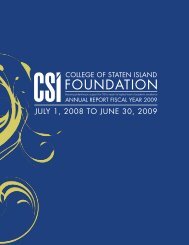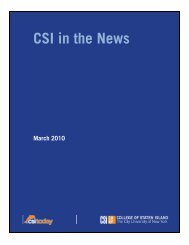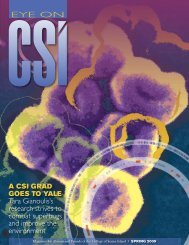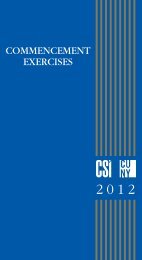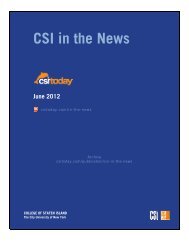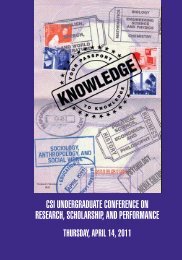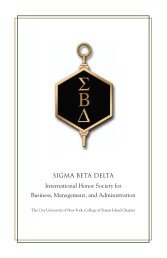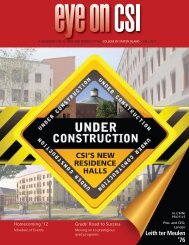CSI in the News October 2011 - CSI Today
CSI in the News October 2011 - CSI Today
CSI in the News October 2011 - CSI Today
- No tags were found...
Create successful ePaper yourself
Turn your PDF publications into a flip-book with our unique Google optimized e-Paper software.
formal tra<strong>in</strong><strong>in</strong>g. Ano<strong>the</strong>r regression model shows that “not only do personal beliefs <strong>in</strong>fluence<strong>in</strong>struction, <strong>the</strong>y also have a stronger impact than any o<strong>the</strong>r factor [<strong>the</strong> authors] have exam<strong>in</strong>ed. At <strong>the</strong>end of <strong>the</strong> day, beliefs are <strong>the</strong> most powerful predictor for teachers on both sides of <strong>the</strong> divide (pp.186,189). [*589]Does that mean that teachers are simply and only free agents? Not exactly. In Chapter 8, Berkman andPlutzer conclude <strong>the</strong>ir empirical <strong>in</strong>quiry with a look at <strong>the</strong> relationship between teachers and <strong>the</strong>ir localcommunities. Us<strong>in</strong>g denom<strong>in</strong>ational membership data and data on <strong>the</strong> percentage of <strong>the</strong> localpopulation hold<strong>in</strong>g advanced degrees, <strong>the</strong>y construct a scale of local culture rang<strong>in</strong>g from“traditionalism” to “cosmopolitanism.” They show that teachers’ personal beliefs about evolution arestrongly related to school district characteristics. What is at work here is a process ak<strong>in</strong> to “assortivemat<strong>in</strong>g” <strong>in</strong> decisions about whom to marry. Here, what is go<strong>in</strong>g on is “assortive hir<strong>in</strong>g and retention.”Teachers tend to look for work with<strong>in</strong> fifteen miles of where <strong>the</strong>y grew up, and districts tend to hireteachers who will “harmonize and fit <strong>in</strong> with <strong>the</strong> prevail<strong>in</strong>g local culture” (pp.199‐200). Teachers,districts, and local residents share values. Overt community pressure is very rare, because often <strong>the</strong>re isno home/school conflict (pp.202‐207). Moreover, even when community op<strong>in</strong>ion is diverse, teachersdevelop ways of avoid<strong>in</strong>g conflict. For example, <strong>the</strong>y might never say <strong>the</strong> word “evolution,” preferr<strong>in</strong>g<strong>in</strong>stead to say “change over time.”Berkman and Plutzer began with <strong>the</strong> question “who decides?” An exhaustive review of public op<strong>in</strong>ion onteach<strong>in</strong>g evolution seemed to reveal that official policy was wildly out of l<strong>in</strong>e with public op<strong>in</strong>ion. Lawand science seemed to have won <strong>the</strong> day. However, closer <strong>in</strong>spection state‐by‐state op<strong>in</strong>ion, statepolicies, and classroom practices revealed a fair amount of “bottom‐up, democratic control,” producedthrough “multiple mechanisms” (p.213). Teachers’ views reflect <strong>the</strong> culture of <strong>the</strong> communities <strong>the</strong>yserve, and those communities are <strong>in</strong>creas<strong>in</strong>gly divided by religion and education. About 20% of allteachers embrace <strong>the</strong> scientific consensus and ano<strong>the</strong>r 20% or so consistently seek to underm<strong>in</strong>e it.That leaves an ambivalent 60% <strong>in</strong> <strong>the</strong> middle, grop<strong>in</strong>g <strong>the</strong>ir way cautiously through <strong>the</strong> m<strong>in</strong>efield. Thiscontroversy, with its “thousands of potential arenas of conflict,” is “dist<strong>in</strong>ctly American.” The nature androle of religion and political decentralization <strong>in</strong> education ensure that <strong>the</strong> conflict will cont<strong>in</strong>ue.One neglected <strong>the</strong>me <strong>in</strong> this work is <strong>the</strong> possible role of race and its relationship to religion and politics(cf: Wadsworth, 2008). The authors note that traditional Protestant black churches are every bit assupportive of creationism as <strong>the</strong>ir white counterparts (pp.71‐72), but, <strong>in</strong>terest<strong>in</strong>gly, <strong>the</strong>y are notpolitically mobilized on <strong>the</strong> evolution issue. The authors surmise that evolution would not be a highpriority for traditional black churches, but <strong>the</strong>y leave it at that. They also note that <strong>the</strong>ir national sampleunderrepresents teachers teach<strong>in</strong>g <strong>in</strong> schools with substantial m<strong>in</strong>ority student populations (pp.118‐19).Race was not <strong>in</strong>cluded as a variable <strong>in</strong> <strong>the</strong> many regression analyses <strong>in</strong> this book (or maybe it was butdidn’t yield any <strong>in</strong>terest<strong>in</strong>g result, so <strong>the</strong> results were not reported). In any event, more susta<strong>in</strong>edattention to race might have filled out <strong>the</strong> picture. To be provocative about this po<strong>in</strong>t, I’m wonder<strong>in</strong>gwhe<strong>the</strong>r <strong>the</strong> strongest proponents of creationism are not also those most ardently devoted to <strong>the</strong>survival of white supremacy. If so, would that matter? Are evolution and a [*590] sense of white racialvictimization part of <strong>the</strong> same larger complex of underly<strong>in</strong>g beliefs?This m<strong>in</strong>or quibble aside, this book has many great virtues. Berkman and Plutzer strike exactly <strong>the</strong> rightbalance between, on <strong>the</strong> one hand, reveal<strong>in</strong>g <strong>the</strong>ir thought processes, describ<strong>in</strong>g <strong>the</strong> operationalizationof <strong>the</strong>ir variable, expla<strong>in</strong><strong>in</strong>g <strong>the</strong>ir regression models, and <strong>the</strong> like, and, on <strong>the</strong> o<strong>the</strong>r hand, susta<strong>in</strong><strong>in</strong>g alively, engag<strong>in</strong>g narrative discussion that keeps <strong>the</strong> reader engaged and th<strong>in</strong>k<strong>in</strong>g and learn<strong>in</strong>g along with<strong>the</strong>m. I would th<strong>in</strong>k that anyone teach<strong>in</strong>g a methods course, whe<strong>the</strong>r at <strong>the</strong> undergraduate or graduatePage 38 of 154



